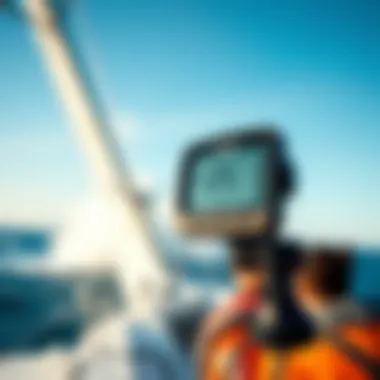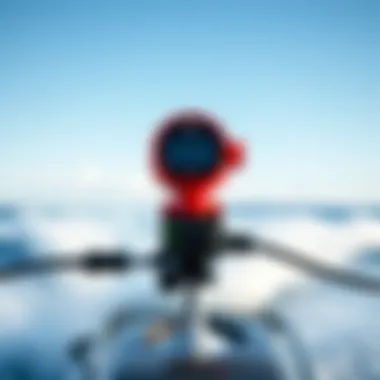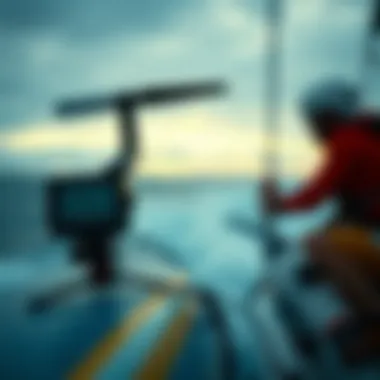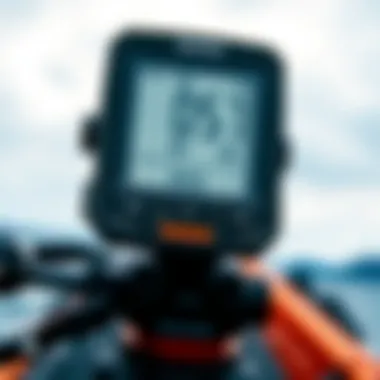Measuring Wind Speed and Direction for Watersports


Intro
Understanding the nuances of wind is crucial for anyone involved in watersports. Wind speed and direction can make the difference between a thrilling day on the water and a disaster waiting to happen. In this article, we’ll take a closer look at the devices that help measure these vital factors. From anemometers to wind vanes, each tool plays its role in ensuring safety and enhancing performance. We’ll dig into how these instruments work, what specific metrics matter, and how varied wind conditions influence water activities.
Tips and Techniques
When it comes to navigating the waters, having a solid grip on wind dynamics is not merely an option but a necessity. Windsurfers, sailors, and kiteboarders all benefit from understanding these elements. Here we present some tips that may help, starting with beginners:
Beginner Tips for Watersports
- Familiarize with Local Conditions: Before you even step on your board or into your boat, take time to look at local wind patterns. Consult resources like weather.gov to track forecasts.
- Invest in a Reliable Anemometer: Start with a basic handheld anemometer. Knowing how strong the wind is before heading out can set the tone for your entire session.
- Learn Wind Basics: Understanding terms such as “upwind” and “downwind” can help you make better decisions on the water.
Advanced Techniques for Mastery
For seasoned athletes, mastering wind measurement can provide a competitive edge:
- Use Data Loggers: Employ advanced devices that can store wind data over time. Analyzing this data can help determine trends and prepare for different conditions.
- Combine Wind Measurements with Performance Metrics: Look for correlations between wind speed and your performance. For instance, do certain speeds yield better results in competitions? Keeping track will elevate your strategy.
- Experiment with Different Gear: Adjust your equipment based on wind conditions. Sometimes a minor tweak in your sail can dramatically impact performance.
Safety and Gear
Safety measures cannot be understated when engaging in watersports. Knowing the wind conditions is half the battle; the other half is preparation:
Essential Safety Practices
- Always Wear a Life Jacket: Regardless of your skill level, a life jacket is an absolute must.
- Stay Informed: Before your outing, check updated weather conditions and forecasts. A sudden change can catch even the most experienced off guard.
- Pair Up: Whenever possible, head out with a buddy. There is safety in numbers, especially in challenging conditions.
Gear Reviews and Recommendations
Selecting the right gear can mean the difference between a successful outing and a perilous situation:
- Anemometers to Consider: Brands like Kestrel and Vaavud offer instruments that are both reliable and user-friendly.
- Wind Vanes to Depend On: Consider models from C. B. Instruments for durable options that are really easy to read.
"Knowledge of wind speed and direction isn't just beneficial—it’s vital for anyone looking to excel in watersports."
By grasping the various devices available for measuring wind speed and direction and adopting the tips discussed, watersport enthusiasts can enhance their experiences and safeguard themselves while savoring every moment on the water. For more insights on this topic, check out britannica.com and reddit.com.
Continue reading to explore more about the specific technologies employed in these devices.
Preface to Wind Measurement
Wind measurement is an essential aspect of many activities, particularly those that take place outdoors, such as watersports. Understanding wind speed and direction is crucial for athletes, coaches, and educators, as these elements can significantly impact performance and safety. Without accurate wind data, individuals may face unexpected challenges, such as changes in conditions that could affect their ability to navigate watercraft or perform maneuvers successfully.
Importance of Wind Speed and Direction
The first impression one might have about wind is that it's just air moving around, but it’s much more nuanced than that. Wind speed and direction are not only crucial for predicting weather patterns, but they also play a vital role in watersports. For instance, sailors depend on knowing wind speed to gauge how much sail to set or whether it is safe to venture out at all.
Wind speed, measured in knots or miles per hour, provides a clear picture of how intense conditions might be. If the wind speed reaches heights of 25 knots, it may well render certain activities, like paddleboarding or kayaking, quite dangerous. Similarly, knowing the direction of the wind allows individuals to align their sails accordingly, ensuring they can take full advantage of favorable conditions while minimizing risks.
"The wind is not only an element to be respected, but also a partner to be understood in every watersport activity."
Overview of Measuring Instruments
To navigate the complexities of wind, a variety of instruments have been developed over the years. These tools vary widely in functionality and precision, catering to different needs and levels of expertise. At the forefront are anemometers and wind vanes.
- Anemometers are devices specifically designed to measure wind speed. They come in various forms, from simple cup models to advanced digital sensors that provide real-time data.
- Wind vanes, on the other hand, are employed to determine the direction of the wind. They serve a fundamental role in many navigational aids, providing critical information to sailors and pilots alike.
With advancements in technology, these instruments have evolved from basic mechanical models to sophisticated electronic devices that can connect to mobile applications, enabling users to monitor wind conditions in real-time from the comfort of their homes or from the water.


Furthermore, knowing the intricacies of these instruments helps academics, travel agents, and bloggers alike to provide accurate and up-to-date information to their respective audiences, thereby enriching the community’s knowledge about safe and enjoyable watersport activities.
For more in-depth information, check out resources from NOAA or NASA's atmospheric science page.
By establishing a firm grasp of the instruments and their functions, individuals can make educated decisions, leading to a safer and more enjoyable experience, no matter the watersport.
Types of Wind Measurement Devices
Understanding the variety of wind measurement devices is crucial for those engaging in watersports and outdoor activities. These devices not only provide critical data that can significantly influence performance but also play a vital role in ensuring safety. Each type of device serves specific needs, and choosing the right one can make the difference between a successful outing and a hazardous situation.
Anemometers
Definition and Functionality
An anemometer is designed primarily to measure wind speed. Its core functionality lies in its ability to convert wind speed into a measurable format that users—like sailors and surfers—can utilize. What distinguishes anemometers in their definition is their reliance on various mechanical or electronic principles to gauge wind. An advantage of anemometers is their ability to deliver real-time data, which is essential for making quick decisions out on the water. However, one must consider that while these devices are reliable, they can also suffer from inaccuracies if not calibrated properly, leading to potential misinformation in critical situations.
Types of Anemometers
There are several types of anemometers, each with distinct functionalities and best-use scenarios. The most notable types include cup anemometers, which are widely recognized for their simplicity and effectiveness, and digital anemometers, offering nuanced data and user-friendly interfaces. The key to their functionality lies in the design; cup anemometers use rotating cups to capture wind speed, while digital ones often integrate sensors that provide detailed reports. A disadvantage of more sophisticated models is their dependency on batteries or electricity, which can be a limiting factor in remote locations.
- Cup Anemometers: Simple, often reliable for general use.
- Digital Anemometers: Provide detailed metrics but need power.
This variety ensures that whether you’re out for a casual sail or engaged in competitive racing, there’s an anemometer to suit your needs.
Applications in Watersports
Anemometers have an essential role in varying watersports, including sailing, windsurfing, and even fishing. They provide real-time feedback that helps performers adjust their strategies based on the wind conditions. One notable feature of these devices is their ability to help predict gust patterns, allowing users to optimize their techniques. However, it's vital to have an understanding of the device’s limitations, as some anemometers may struggle in turbulent conditions or fail to offer accurate readings in variable wind patterns.
Using an anemometer can enhance performance, but recognition of its limitations is equally important.
Wind Vanes
How Wind Vanes Work
Wind vanes serve a different purpose from anemometers; their primary job is to indicate the direction of the wind. Typically mounted on a pole, the vane consists of a rotating blade that aligns itself with the wind flow. This simple yet effective mechanism allows users to gain insight into wind direction, which can be crucial for navigation and planning. One main advantage of wind vanes is their durability; they often withstand varied weather conditions without fail. On the other hand, they do not provide speed measurements, which makes them less comprehensive on their own for those seeking detailed wind data.
Types of Wind Vanes
Wind vanes also come in multiple varieties, like stationary and electronic models. Stationary wind vanes are often used for basic readings and are typically durable but may lack the precision of their electronic counterparts. Electronic wind vanes can provide more detailed data, such as average wind direction over time, making them increasingly popular among serious enthusiasts. A downside is that electronic models require regular maintenance to ensure accurate readings, which isn't the case for simpler designs.
- Stationary Wind Vanes: Great for beginners, very durable.
- Electronic Wind Vanes: Provide detailed analytics but need upkeep.
Choosing the right type can depend on the user’s specific needs during their activities.
Significance in Navigation
Understanding wind direction is especially crucial for navigational purposes in watersports. Wind vanes can guide sailors and surfers as they maneuver their crafts, ensuring they can align with wind currents effectively. They play a vital role in strategic sailing—where adjusting the sail according to wind direction can enhance speed and control dramatically. However, a limitation arises when users solely rely on wind vanes without additional instruments; directional insight without speed data can lead to poor decision-making in fast-changing weather conditions.
Technological Advancements in Wind Measurement
In the realm of wind measurement, ongoing advancements are crucial. Technology has forever changed how we measure wind speed and direction, ushering in new possibilities for accuracy and user-friendliness. As the demand for precise wind data grows among athletes, coaches, and technical experts, understanding these innovations can significantly enhance performance, safety, and decision-making.
Digital vs. Analog Instruments
Digital instruments have become significantly favored compared to their analog counterparts. Here's why:
- Precision and Accuracy: Digital devices often offer higher precision. They can measure wind changes in real-time, displaying results that are easy to read and interpret.
- Data Storage and Analysis: Many digital models include storage options allowing users to save historically relevant data for analysis. This feature can be beneficial for athletes who rely on past performance metrics to improve.
- Ease of Use: Generally, operating these devices is straightforward, with clear displays and minimal manual input required.


On the flip side, analog instruments, although somewhat obsolete, have their merits as well:
- Simplicity: Some users prefer analog devices for their simplicity and reliability. They don't rely on batteries or complex electronics.
- Durability: In harsh conditions, analog devices may demonstrate greater robustness, unbothered by potential electronic failures.
Ultimately, the choice depends on user preference and specific needs. The consistent drive toward digital technology, however, seems inevitable, given its advantages.
Integration with Mobile Applications
The integration of mobile applications with wind measurement tools stands out as a noteworthy trend. Let's explore this development:
- Instantaneous Access: Users can receive and analyze wind data on their smartphones, allowing them to make on-the-spot decisions. This capability is particularly beneficial during outdoor activities like sailing or kiteboarding, where conditions can shift quickly.
- Real-Time Sharing: Social connectivity is also enhanced through apps. Users can share conditions with their peers, fostering a community of informed athletes.
- Customization: Many apps offer personalization elements. Users can set up alerts for specific wind conditions, making it easier to plan training or competition sessions efficiently.
In summary, technological advancements, from digital conveniences to robust mobile applications, profoundly affect how users interact with wind measurement devices. These elements not only allow for enhanced performance but also cater to a growing demand for flexibility and immediacy in data access and analysis.
Factors Affecting Wind Measurement
Measuring wind speed and direction isn’t as straightforward as it may first appear. Various factors can skew readings, impacting athletes, coaches, and others relying on precise wind data, especially in watersports. Understanding these nuances helps ensure that provided information is accurate and actionable. This section dives into two primary influences on wind measurement: environmental elements and challenges related to calibration and accuracy.
Environmental Influences
Environmental factors play a significant role in the reliability and accuracy of wind measurement instruments. These elements can come from both natural and artificial sources.
- Topography: The physical landscape significantly affects wind patterns. Mountains can create areas of turbulence as winds flow over uneven surfaces, leading to faster gusts or sudden drops in speed. Areas near large bodies of water may also experience varied wind behaviors, as the temp differences between land and water create localized breezes.
- Obstructions: Buildings, trees, and other structures can interfere with wind flow. These obstructions may create wind shadows, where the speed noticeably decreases in their vicinity. This means that measurements taken in urban areas may not mirror those over open water.
- Weather Conditions: Changes in atmospheric pressure and temperature can also influence wind measurements. For example, during a storm, wind speed can drastically increase, while clear conditions may create steadier but often calmer winds. Understanding the broader meteorological context is crucial for accurate data.
- Time of Day: Wind patterns can shift based on the time of day due to heating from the sun. Typically, winds might be calmer during the early morning, while afternoons can bring updrafts as the air heats up.
This understanding aids athletes in making informed decisions, ensuring safety and optimizing performance by considering the specific environment where they operate.
Calibration and Accuracy
Calibration remains a cornerstone of reliable wind measurement. It’s crucial to recognize that even the best devices can yield erroneous readings without proper calibration processes.
- Device Calibration: Instruments like anemometers and wind vanes need to be calibrated regularly to ensure consistent and correct measurements. This means comparing the readings from these devices against known standards or more accurate instruments.
- Usage and Maintenance: Frequent use or environmental exposure can cause wear and tear, which may affect accuracy. For example, dust buildup can alter the sensor's ability to respond to wind changes, leading to misleading data.
- Temperature Effects: Temperature can also influence the readings of certain devices. For instance, electronics are often susceptible to temperature fluctuations, leading to inaccurate wind speed readings in extreme conditions.
"Accurate wind data is not just numbers; it strengthens the very foundation of strategic decision-making in watersports."
Ensuring optimal calibration practices can significantly enhance the reliability of wind data, ultimately benefiting users from sailing enthusiasts to competitive athletes.
By being aware of these influencing factors, users can interpret wind data with a discerning eye, elevating their understanding, performance and safety in any water-based activity.
Practical Applications of Wind Measurement in Watersports
Understanding how wind speed and direction play a vital role in watersports can't be overstated. In activities like sailing, surfing, and kiteboarding, accurate wind measurements shape the experiences of athletes and enthusiasts alike. By integrating specific metrics into these sports, participants can maximize their performance, enhance safety, and adapt to changing environmental conditions. This section will dissect how wind measurement applies practically to each watersport, evidencing its pivotal significance in optimizing outcomes.
Sailing
Sailing is perhaps the most wind-dependent of all watersports. Sailors rely on precise wind measurements to manipulate sail position effectively, an art that combines science and intuition. A sailor understands that each wind speed has its pros and cons; for instance, light winds may call for a more expansive sail setup to catch every breeze, while strong winds might necessitate smaller sails for better control.
Key Considerations for Sailors:
- Wind Speed: Knowing whether it's a light breeze or gale can dictate when to set sail and how to adjust sails conceptually.
- Wind Direction: This influences the sailing course significantly. Is it a headwind or a tailwind? This can decide whether to tack or run.
These elements not only decide the sailor's strategy but also impact their safety on the water. Regularly consulting updated wind data can mean the difference between dodging heavy weather and being caught in treacherous conditions.
Surfing
Surfing, while often seen as a wave-riding experience, is intricately tied to wind conditions. The wind's effect on waves -- whether it acts as a groomer or creates disjointed swells -- can profoundly influence a surfer's day at the beach.
Impact of Wind on Surfing Conditions:


- Onshore Winds: Create choppy waves that can be difficult to ride.
- Offshore Winds: Often lead to cleaner, more organized waves, improving surf quality.
For surfers, monitoring wind conditions through reliable measurement devices gives essential insights into when and where tides will be favorable, ultimately shaping a successful session or, conversely, a waste of time.
Kiteboarding
Kiteboarding fills a thrilling niche in watersports heavily reliant on wind intensity and direction. Here, the art of reading wind conditions grows increasingly nuanced.
Kiteboarders need to know precisely:
- Optimal Wind Speeds: Different kite sizes work better in specific ranges. Too much wind can lead to loss of control, while too little can render the session lackluster.
- Wind Direction: Affects not just the navigation path but the overall strategy for jumps and tricks.
Decisions stem from comprehending real-time data about these aspects. A kiteboarder whose gear is suited for the day’s conditions will always have an edge over one who isn't informed.
Implications for Safety
Safety is paramount, particularly on the open water where conditions can change in a heartbeat. The significance of accurate wind data for preventing accidents and ensuring an enjoyable experience cannot be ignored. Wind measurements alert athletes and watercraft operators about crucial shifts in conditions that could lead to risks like capsizing or collisions.
"Being informed about the wind keeps you one step ahead, particularly in a sport defined by its unpredictable elements."
Safety Considerations:
- Up-to-Date Metrics: Wind measurements should be checked regularly, especially before beginning any watersports.
- Awareness of Changes: Understanding how sudden changes impact sailing, surfing, or kiteboarding can avert risky scenarios.
By remaining vigilant about wind conditions and reacting accordingly, athletes can enjoy their sporting endeavors while minimising hazards associated with nature's unpredictability.
Future Trends in Wind Measurement
As we navigate through an increasingly unpredictable climate, the role of wind measurement devices is becoming more crucial. Understanding the future trends in wind measurement offers insights that extend beyond just enhancing performance in watersports. These advancements promise reliability, increased accuracy, and sustainability, making them vital for both enthusiasts and professionals alike.
Emerging Technologies
The future of wind measurement is inextricably linked to burgeoning technological innovations. Here are some key developments worth noting:
- Smart Sensors: Traditional anemometers and wind vanes are being upgraded with smart sensors capable of collecting and transmitting data in real-time. These devices often come with GPS integration, making it easier to track wind patterns across various locations.
- Artificial Intelligence: AI algorithms are increasingly employed to analyze data collected from these instruments. This can lead to predictive insights on wind patterns based on historical data, thus allowing athletes to prepare better for competitions or recreational activities.
- IoT Integration: The Internet of Things (IoT) is paving the way for interconnected devices in the realm of wind measurement. IoT-enabled devices can share data among themselves and provide users with a holistic view of weather conditions, making decision-making seamless and informed.
"As technologies evolve, the ability to collect, analyze, and distribute wind data will enhance safety and performance in watersports."
These advancements not only improve measurement accuracy but also enhance user experience by making data more accessible and actionable.
Sustainability and Wind Measurement
In a world increasingly focused on sustainability, the wind measurement sector is not lagging behind. Here are some ways this area is embracing eco-friendly practices:
- Solar-Powered Devices: Newer models of anemometers and wind vanes are designed to be power-efficient and rely on solar energy. This reduces the ecological footprint of these instruments while ensuring they remain operational even in remote locations.
- Material Innovations: Manufacturers are exploring lighter, more durable materials for building these devices, leading to a reduction in waste and more environmentally friendly production processes.
- Data-Driven Conservation Efforts: By gathering accurate wind data, organizations can make more informed decisions about conservation and land management. This aids in protecting both aquatic environments and the sports reliant on them.
The emphasis on sustainability not only reflects a growing societal responsibility but also represents a strategic advantage for those involved in the watersports community. As athletes and coaches become more aware of environmental impacts, their choice of measurement devices is likely to reflect a commitment to greener practices.
By staying abreast of these future trends, individuals in the watersports sphere can enhance their skills while contributing positively to the planet. The evolution of wind measurement technology may soon reshape how we interact with our environment, turning challenges into opportunities.
Epilogue
In summation, the role of accurate wind data in watersports is paramount. It goes beyond mere numbers on a device; it can make the difference between a thrilling experience and a hazardous one. Understanding wind conditions is essential for optimizing performance and ensuring safety.
1. Performance Optimization: For athletes and enthusiasts alike, knowledge of wind speed and direction can enhance their skills. For instance, in sailing, understanding when to maximize sail height and angle can propel a vessel faster than competitors, giving sailors that edge they seek during races. Similarly, surfers need to know the wind patterns to choose the best waves. Without this knowledge, riders may find themselves paddling into unfavorable conditions, hindering their experience and performance.
2. Safety Considerations: Wind can change as swiftly as the tide. A gentle breeze can morph into a fierce gale with little warning, particularly for watercraft. Both sailors and surfers must be equipped with reliable wind measurement devices to ensure they can react promptly. Accurate data aids in predicting weather changes, allowing participants to make informed decisions about when to hit the water or if conditions are too risky. Safety should never be compromised, and a trustworthy anemometer or wind vane can signal when it’s time to back off.
3. Long-term Insights: As watersport enthusiasts become more attuned to wind patterns, their ability to interpret and anticipate conditions improves. Over time, this knowledge fosters a deeper relationship with their chosen sports. It allows them to explore new locations confidently, knowing how wind affects their experience. Coaches and instructors can impart this knowledge to new participants, creating a community that values safety and skill.
By integrating the insights from wind measuring devices into their routine, athletes and coaches not only enhance their performance but develop a nuanced understanding of their environment. This awareness is invaluable, augmenting both enjoyment and danger mitigation in watersports.
As this article lays out, from the workings of basic instruments to technological advancements, comprehending these tools becomes part of a comprehensive approach to engaging with wind and water. The importance of accurate wind data can not be overstated; it is both the compass and a safeguard for all who dare to embrace the currents.















